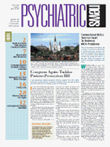There has been a longstanding debate over whether schizophrenia might be more than one disease, because schizophrenia patients vary so much in symptoms and treatment response.
That debate may now be easing somewhat. For, as William Carpenter Jr., M.D., director of the Maryland Psychiatric Research Center and a professor of psychiatry and pharmacology at the University of Maryland School of Medicine, told Psychiatric News, “We think we have teased out a disease subgroup within schizophrenia.”
Besides Carpenter, the scientists include Brian Kirkpatrick, M.D., and Robert Buchanan, M.D., both of the Maryland Psychiatric Research Center and the University of Maryland School of Medicine, and David Ross, M.D., of the Medical College of Virginia.
Indeed, Carpenter and his coworkers make their case for a subtype of schizophrenia in the February Archives of General Psychiatry. They not only lay out their hypothesis for it, but also describe a number of studies that support it. And while the bulk of the research derives from their own labs, some comes from other groups as well.
Ezra Susser, M.D., a psychiatrist and head of the division of epidemiology at Columbia University School of Public Health, is familiar with the research by Carpenter and his colleagues. “This line of investigation is one of the most promising in schizophrenia research,” he said in an interview.
Morris Goldman, M.D., an associate professor of psychiatry and director of research at the Psychiatric Institute of the University of Chicago, is also familiar with the research by Carpenter and his team. “They have presented a very good argument that this may constitute a separate subset of patients,” he told Psychiatric News.
The subtype of schizophrenia that Carpenter and his coworkers believe they have identified has been named “deficit schizophrenia.” It describes patients who have irreversible forms of negative symptoms. Such patients appear to be different from nondeficit schizophrenia patients in their neuropathology, treatment response, risk factors, and neuroimaging.
For instance, the deficit patients tend to have poorer social and occupational function than do nondeficit patients. Yet despite their poorer social and occupational function, they experience less depression and fewer suicidal thoughts.
Whereas antipsychotic drugs have been shown to be effective against positive symptoms in both deficit and nondeficit schizophrenia, they appear to be effective against negative symptoms only in nondeficit schizophrenia patients.
Although antibodies to the Borna disease virus—an RNA virus with worldwide distribution and a possible cause of schizophrenia—have been found in both deficit and nondeficit schizophrenia patients, the level of such antibodies is higher in the former. What’s more, these antibodies appear to be associated with the severity of negative symptoms. (The deficit group may also have higher levels of antibodies against other pathogens as well; the possibility has not yet been tested.) And while being born in winter has long been associated with schizophrenia, deficit schizophrenia has been linked to being born in the summer.
As for anatomical and physiological differences between the two groups, the deficit group is more impaired in the frontal lobes and parietal lobes, in sensory integration (which is thought to be related to frontal and parietal function), and in oculomotor function.
If deficit schizophrenia indeed pans out as a subtype of schizophrenia, what would the implications be? “We may be able to discover causes of deficit schizophrenia that would otherwise be obscured by heterogeneity among individuals diagnosed as having schizophrenia,” Susser said.
Another implication, Goldman pointed out, is that if deficit schizophrenia—a type of schizophrenia that is especially resistant to treatment—truly exists, then researchers can focus on it in their treatment efforts. And still a third implication, Goldman added, is the intriguing similarity between deficit schizophrenia and autism.
The article “A Separate Disease Within the Syndrome of Schizophrenia” is posted on the Web at archpsyc.ama-assn.org. ▪
